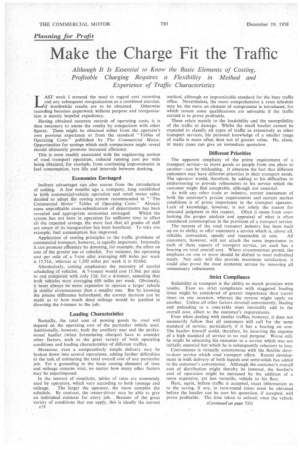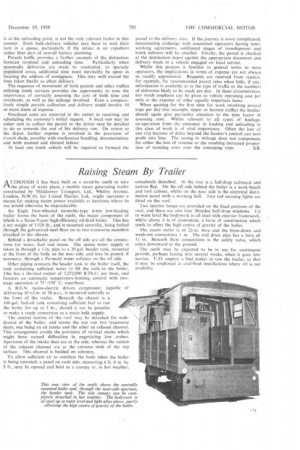Make the Charge Fit the Traffic
Page 62

Page 65

If you've noticed an error in this article please click here to report it so we can fix it.
Although It Is Essential to Know the Basic Elements of Costing, Profitable Charging Requires a Flexibility in Method and Experience of Traffic Characteristics
LAST week I stressed the need to regard cost recording and any subsequent reorganization as a combined exercise,
if Worthwhile results are to be obtained. Otherwise recording becomes paperwork without purpose and reorganization is merely hopeful expediency.
Having obtained accurate records of operating costs, it is then necessary to assess the results by comparison with other figures. These might be obtained either from the operator's own previous experience or from the standard " Tables of Operating Costs" published by The Commercial Motor. Opportunities for savings Which such comparisons might reveal should ultimately promote increased efficiency.
-This is most readily associated with the engineering section of road transport operation, reduced running cost per mile being obtained, for example, from continuing improvements in fuel consumption, tyre life and intervals between docking.
Economies Envisaged
Indirect advantages can also accrue from the introdUction of costing. A few months ago a company, long established in both commercial-vehicle operation and retail motor sates, decided to adopt the costing system recommended in "'The Commercial Motor' Tables of Operating Costs." Already some unprofitable cross-subsidization of departments has been
revealed and appropriate economies envisaged. Whilst the system has not been in operation for sufficient time to effect all the expected savings, the mere fact that all grades of staff arc aware of its inauguration has been beneficial. To take one example, ftiel consumption has improved.
Application of costing principles to the traffic problems of commercial transport, however, is equally important. Internally it can promote efficiency by denoting, for example, the effect on cost of the greater use of vehicles. For instance, the operating cost per mile of a 5-ton oiler, averaging 400 miles per week is 15.51d., whereas at 1,200 miles per week it is 10.68d.
Alternatively, costing emphasizes the necessity of careful .scheduling of vehicles. A 7-tonner would cost 15.36d. per mile to run compared, with only 12d. for a 4-tonner, assuming that both vehicles were averaging 600 miles per week. Obviously, it must always be more expensive to operate a larger,vehicle in similar circumstances than a smaller one. But by knowing the precise 'difference beforehand, the correct decision can be made as to how. much dead mileage would be justified in diverting the 4-tonner to the job, Loading Characteristics
Basically, the total cost of moving goods by road will depend on the operating cost of the particular vehicle used. Additionally, however, both the ancillary user and the professional haulier (when formulating charges) have to consider other factors, such as the great variety of both operating conditions and loading characteristics of different traffics.
Moreover, even a comparatively simple delivery may be broken down into several operations, adding further difficulties to the task of estimating the total overall cost of any particular job. Yet a grounding in the basic costing elements of time and mileage remains vital, no matter how many other factors may be superimposed.
In the interest of simplicity, tables of rates are commonly used by operators, which vary according to both tonnage and mileage. The larger the operator, the more complex the schedule. By contrast, the owner-driver may be able to give an individual estimate for every job. Because of the great variety of conditions that can apply, this is ideally the correct method, although an impracticable standard for the busy traffic office. Nevertheless, the more comprehensive a rates schedule may be, the more an element of compromise is introduced, for which reason some qualifications are advisable if the traffic carried is to prove profitable.
These relate mainly to the loadability and the susceptibility of the traffic to damage. Whilst the small haulier cannot be expected to classify all types of traffic as extensively as other transport services, his personal knowledge of a smaller range of traffic is more often than not of greater value. He, alone, in many cases can give an immediate quotation.
Different Priorities The apparent simplicity of the prime requirement of a transport service—to move goods or people from one place to another—can be misleading. It obscures the fact that different customers may have different priorities in their transport needs. The operator would, therefore, he adding to his difficulties in endeavouring to provide refinements to his service which the customer., might find acceptable, although not essential.
' As with any other trade or industry, correct assessment of both the customer's precise requirements and current market conditions is of prime importance to the transport operator. Lack of knowledge, however, is not solely the reason for unsound judgment in this respect. Often it stems from overlooking the proper analysis and appraisal of what is often considered commonplue in the provision of a transport service.
The success of the road transport industry, has been built up on its ability to offer customers a service which is, above all,
reliable, convenient, speedy and reasonable in cost. All customers, however, will not attach the same importance to each of 'these aspects of transport service, yet each has a bearing on total overall cost. Where circumstances permit, the emphasis on one or more should be shifted to meet individual needs. Not only will this provide maximum satisfaction; it could also prove the most economic service by removing all unnecessary refinements.
Stria Compliance
Reliability, in transport is the ability to match promises with results: Even so, strict compliance with staggered loading times might be considered of greater importance than transit times on one occasion, whereas the reverse might apply on another. Unless all other factors dovetail conveniently, lbading and unloading to a time-table must inevitably add to the overall cost, albeit to the customer's requirements.
Even when dealing with similar traffics, however, it does not necessarily follow that all customers will call for the same standard of service, particularly if it has a bearing on cost. The haulier himself could, therefore, be incurring the expense of a high standard of service to no real purpose. Worse still, he might be educating his customer to a service which was not initially essential but which he is subsequently reluctant to lose.
Convenience is virtually synonymous with the flexible doorto-door service which road transport offers. Recent development in bulk delivery of both liquids and semi-solids has added to the customer's convenience. Although the customer's overall cost of distribution might thereby be lowered, the haulier's cost of operation might be increased by the addition of a more expensive; yet less versatile, vehicle to his fleet.
Here, again, before traffic is accepted, exact information as to the saving, if any, in turn-round times must be obtained before the haulier can be sure his quotation, if accepted, will prove profitable. The time taken to unload, once the vehicle
is at the unloading point, is not the only relevant factor in this context. Even bulk-delivery vehicles may have to wait their turn in a queue, particularly if the intake is an expedient rather than part of overall factory planning.
Parcels traffic provides a further example of the distinction between terminal and unloading time Particularly when spasmodic deliveries are made to residential, or sparsely populated areas, additional time must inevitably, be spent in locating the address of consignees. This rnay well exceed the time taken'finally to effect delivery.
The sequence of movement Of -both parcels and other traffics utilizing trunk services provides the opportunity to note the importance of correctly assessing the cost of both time and overheads, as well as the mileage involved. Even a comparatively simple parcels collection and delivery Could 'involve 10 or more items of expense.
-Overhead costs are incurred: at the outset in receiving and scheth:fing the customer's initial request. A local van may be either sent to collect the parcel or the driver. may be detailed to do so towards the end a his delivery run. On return. to the depot, further expense is involved in the provision of transit sheds, possibly with mechanical handling, documentation and both manual and Clerical labour,
At least one trunk vehicle will be required to forward the parcel to the delivery area, lithe journey is more complicated, necessitating exchange with associated operators having interworking agreements, additional stages of transhipment and trunk delivery will be entailed. Finally, the parcel-is checked at the _destination depot against the appropriate document and delivery Made in a vehicle engaged on local service.
Whilst this process is familiar in general terms to most operators, the implications in terms of expense art not always so readily appreciated, Requests are received from readers, for example, for recommended parcel rates when little, if any, information is available as to the type of traffic or the numbers
.deliveries likely to be made per day. In these circumstances. too much emphasis. can be -given to vehicle operating cost per mile at the -expense of other equally important items.
When quoting for the first time for work involving several trips per day tfor example, tipper or harvest traffic) the haulier shOuld again -give particular attention to the time factor in assessing cost. Whilst relevant to all types of haulage, co-operation from thc customer in loading and unloading in this class of work is of vital importance. Often the loss •of one trip because of delay beyond the haulier's control can turn profit into loss. The saving in mileage does not compensate for either the loss of revenue or the resulting increased proportion of standing costs over the remaining trips.




































































































